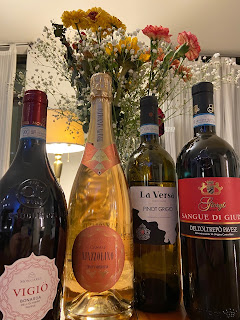The world of wine seems to get wider all the time, as new countries offer exciting indigenous grapes to a curious American market. I recently attended a media lunch at Avra Estiatoria hosted by Marinela Ardelean, ambassador to the Open the Romanian Wine program. This eastern European country offers Americans unique varieties, sophisticated winemaking, and new flavors to explore -- all while boasting a winemaking tradition that goes back 6000 years. Romania has seven wine regions with nearly 500 wineries that grow 165 grape varieties. At this media lunch, Marinela only selected wines made from native grapes for us to sample.
The first was a sparkling wine, The Iconic Estate's Rhein Extra Magnifique Brut. This off-dry sparkler with notes of lime was made in the traditional method of having a second fermentation in the bottle, similar to Champagne.
Next we were treated to a duo of roses. The Iconic Estate Hyperion Rose Feteasca Neagra had an inviting nose of savory herbs and on the palate there were strawberries and good acid. The second rose was noticably paler in color and more intensely aromantic - with aromas of lychee and white flowers. This was from Domeniile Averesti, the Spectrum Busuioaca de Bohotin -- legend says this wine was drunk by Stefan the Great. The wine had a perceptible sweetness balanced by lime and cranberry on the palate.
Our first red was light-bodied and fresh, La Sapata Babeasca Neagra from Crama Delta Dunarii. The wine offered a mix of berry flavors and a dash of balsamic in a refreshing wine that can be served slightly chilled.
We moved on to The Iconic Estate Hyperion Feteasca Neagra 2016, a medium-bodied red with good balance of red and black fruit, acid, and tannin.
The Avincis - Olt de Vie Negru de Dragasani had a deep garnet color, a rich tannic structure, black and red fruit, and a long finish - definitely a wine that can age but which was also delicious at its current state.
The group of American media and wine professionals agreed that the Romanian wines we tried were deliciously food-friendly with the ample spread of Greek dishes we tried at Avra. They were all very palatable -- but also offered unique flavor notes and aromas. These nuanced differences make Romanian wines a great find for curious wine consumers who are looking for new taste sensations to explore.


































